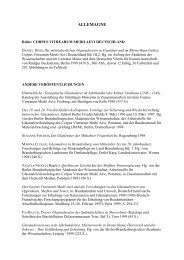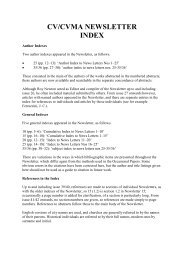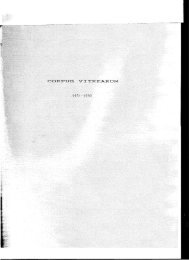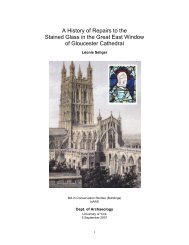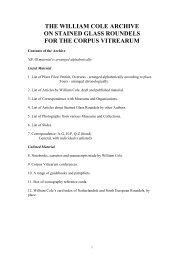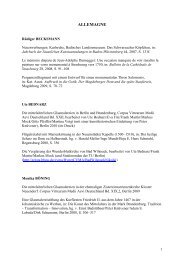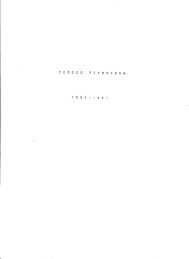BristolConference - Corpus Vitrearum Medii Aevi
BristolConference - Corpus Vitrearum Medii Aevi
BristolConference - Corpus Vitrearum Medii Aevi
You also want an ePaper? Increase the reach of your titles
YUMPU automatically turns print PDFs into web optimized ePapers that Google loves.
that were replaced by three larger windows<br />
(sVII-IX),c.1840. These were given by members<br />
of the community and contained angels and<br />
saints, including a St Sebastian now in the east<br />
window. Further east, in a small blocked<br />
Romanesque opening in the cloister door, the<br />
monks were reminded of their mortality.<br />
Rushforth interpreted the scene, known only<br />
from antiquarian sources, as an angel battling<br />
with demons for the soul of a dying monk, an<br />
image popular in 15 th -century Books of Hours.<br />
Architectural changes to the west window (W)<br />
have produced an eccentric design. Little<br />
original glass has survived because of the<br />
exposed position. Originally the main lights<br />
contained the Virgin, flanked by six female<br />
martyr saints. Appropriately, given the western<br />
location, the tracery contained an extensive<br />
Doom. A few scattered fragments remain,<br />
mainly in the east window. Two tracery lights<br />
(B1, B2) once contained the arms of Richard,<br />
Duke of Gloucester (the future Richard III) and<br />
his wife, Anne Neville (married 1474),who may<br />
have given the window shortly before<br />
Richard's coronation in 1483. His shield and<br />
other heraldic fragments are now in the choir<br />
(SIVand nV). Many of the ecclesiastics,female<br />
saints, martyrs and angels now occupying the<br />
window were moved from the north nave<br />
clerestory.<br />
North Transept (nVI and nVII)<br />
The glazing of Malvern Priory was completed<br />
at the beginning of the 16 th century by one of<br />
the most spectacular windows in the church.<br />
Despite storm damage in the early 18 th century<br />
the Magnificat Window (nVI) in the north<br />
gable wall is the finest expression of the cult of<br />
the Virgin at Malvern. Its main subject, Eleven<br />
Joys of the Virgin, are represented by scenes<br />
illustrating verses from the Magnificat, which<br />
were accompanied by quotations from the<br />
canticle and Gaude inscriptions summarizing<br />
each scene. These commence with the<br />
Annunciation and end with a large Coronation,<br />
off-centre and, unusually for an English design,<br />
spread across three lights. The Coronation is<br />
largely reconstructed, but the flanking<br />
patriarchs are well preserved. The Gaude verses<br />
beneath the Virgin are taken from a work<br />
attributed to St Herman [oseph of Steinfeld,<br />
another example of continental inspiration.<br />
Both of the Priory's patron saints were<br />
included, as St Michael and his fellow<br />
archangels, now much battered, frame the<br />
scenes. Female saints and angels fill the tracery.<br />
Across the base of the window are the remains<br />
of six donor figures, Sir Thomas Lovell, SirJohn<br />
Savage (largely lost), Sir Reginald Bray,Arthur<br />
Prince of Wales (d.1502), Queen Elizabeth of<br />
York (lost) and Henry VII. The inscription<br />
below, which mentions Katherine of Aragon<br />
who married Arthur in 1501,and the inclusion<br />
of Elizabeth, who died in 1502, suggests the<br />
glass can be dated very precisely to 1501-1502.<br />
The presence of the three local knights, rather<br />
than further royal children, may indicate<br />
that this was not a straightforward royal<br />
commission.<br />
Richard Marks has attributed the window to<br />
the workshop of Richard Twygge and Thomas<br />
Wodshawe on the basis of their documented<br />
work at Tattershall, Lincolnshire, 1482.He has<br />
also identified these glaziers in Gloucestershire<br />
(including the Lady Chapel of Gloucester<br />
Cathedral), Nottinghamshire, Warwickshire<br />
and, above all, Worcestershire itself. Documents<br />
show Twygge working at Westminster Abbey<br />
in 1505-10when a glazier from Malvern is also<br />
mentioned. It seems likely that the workshop<br />
had a Worcestershire base, possibly in Malvern<br />
itself, where it also executed the east window<br />
of Little Malvern Priory (1480-82).<br />
At Malvern it is possible to trace the<br />
development of native glass-painting over a<br />
virtually continuous period of some seventy to<br />
eighty years, beginning with the International<br />
Gothic style in the east window and ending<br />
with the more pictorial style of the transept.<br />
Malvern was not a particularly wealthy or<br />
prestigious house, but its glazing was well<br />
served by a combination of monastic and local<br />
lay donors, reinforced by a few very prestigious<br />
national figures. The wholesale movement of<br />
panels disturbs any neat historical overview,<br />
but for a conference on lay piety it provides a<br />
wealth of images to admire and discuss.<br />
Bibliography<br />
G. McN.Rushforth,Medieval Christian Imagery,<br />
Oxford,1936<br />
D.O'Connor<br />
33



